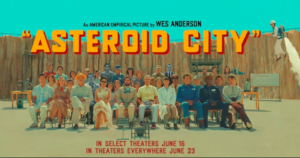.
I do not have a deep history with Wes Anderson having seen only two of his films before yesterday’s screening of Asteroid City. (The two films being Rushmore which did not emotionally connect with me in any manner, and The Grand Budapest Hotel, which I thoroughly enjoyed.)
Asteroid City is more like The Grand Budapest Hotel in tone and visual style than Rushmoreand as such I was happy to roll the dice and see this in the theater with my sweetie-wife.
The film is structed as a story within a story with the framing narrative a television broadcast,
presented in black & white and in television’s aspect ratio, about the writing and performance of the play Asteroid City, which deals with a collection of disparate and quirky characters that fate has brought together in the titular town and is the interior narrative of the structure.
The film struck me as more of an expression of tone than rather a more traditional narrative exercise. While there are character arcs and plot obstacles in both the frame and the interior stories, neither are presented as the principal reason for experiencing this production. Rather it is the emotional reaction that is the driving force of the script. Anderson frames, films, and directs the performances of his immensely talented cast in a manner that creates an unreal artificiality, informing the audience that while the events are heightened abstract versions of plot elements but leaving the emotional resonances untouched.
Asteroid City is not a film for everyone. It’s highly stylized production and performance will be distancing to some but charming and engaging to others. However if The Grand Budapest Hotel, which utilized very similar devices, worked for you than it is likely your will find your time stranded in Asteroid City equally enjoyable.

